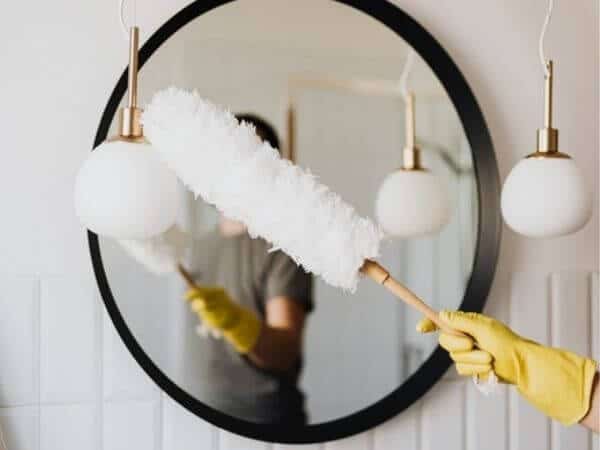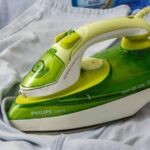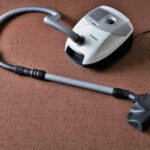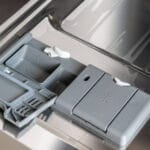Whether you are cleaning your house or a more dirtier place like the garage, your cleaning procedure is a significant determinant for how clean the place looks in the end. So, should you vacuum or dust first?
Cleaning experts such as Merry Maids recommend that you dust first. Essentially, dust settles on the floor and vacuuming first means that you will still end up with a dirty house.
Personally, I begin my cleaning process by arranging disorganized areas, dusting, and finish up by vacuuming, sweeping or mopping.
Also read: Can you vacuum glass
Vacuum or Dust First?
The answer to whether you should vacuum or dust first is straight up logic. You want to follow a procedure that will get most of the dirt out, and leave zero dust particles floating in the air if that is even possible to achieve. So here is the deal! Start by dusting using a microfiber cloth, a microfiber duster or a disposable swiffer duster. Finish up by vacuuming. With a good vacuum, you should capture almost 99 % of the dust, pet dander, dust mites and everything else that lurks as dirt in your home.
Since this procedure is easier said than done, I outline a detailed guide on how you should clean your house and turn it into a have for you and your family members.
Arranging Disorganized Areas

Essentially, an active home gets disorganized soon after tidying up. Moms know this better because kids are always all over the place, doing the most with their slime, crayons, playdough, nuggets and everything else that seems to keep the fun and games going.
As soon as you stack back different things to where they belong, the little ones come right after and disorganize the place with little regard for your monumental effort.
But kids are not the only culprits for getting a house disorganized. Even a home with adults only and zero pets still gets to a point where it needs to be reorganized. Sometimes it can be one cluttered room or little piling up problems in every room.
If you intend to clean the entire house thoroughly, it is best to arrange one room at a time. Personally, I begin with the room that requires most work so that it can be done by the time I get tired.
Want to know other ways to keep you pumped up for the task? You can read some encouraging spring or home cleaning quotes. Or even better, you can drink from Marie Kondo’s tested and proven cup of home cleaning and organizing wisdom.
Home Organizing Tips
Some of the best home organizing tips that I have discovered over the last few years include:
- Taking time to organize a small area of the house every day: Although this might come in the way of a busy day, it helps ensure that your entire house does not get completely disorganized gradually.
- Placing a bin at the front door: The key for this tip is to prevent yourself and others from bringing litter into the house.
- Placing a bin at every point that gets littered easily: This allows you to control how you handle litter within the house.
- Cleaning utensils as they get dirty: Dirty utensils can pile up quickly and turn the entire kitchen into a mess. Cleaning a cup, plate, spoon or any other kitchen tool immediately after use spares you an hour or two that can be spent tidying up the kitchen.
- Decluttering: Organizing a house is a great idea. However, it becomes pointless if you have things that you do not need filling up the entire space. Move from room to room looking for such items and donate them. In addition, throw away the ones that are completely useless.
- You can also move things that you intend to use at a later time to the garage or any other space that is rarely used in your house or home compound.
- Use the available space well: Maximize on space by ensuring proper utilization of shelves, drawers, under the kitchen sink area, and other available spaces in your house.
- Invest in organizers: Organizing tools are particularly fundamental in the kitchen and bedroom. They allow you to find the appropriate place for everything. For example, storage baskets are useful for keeping groceries organized in the kitchen. Similarly, a laundry basket keeps dirty clothes organized in the bedroom.
- Do not buy things for future use: The temptation to buy things you do not need for immediate use is normal. However, when making such purchases becomes a habit, your house gradually gets cluttered and becomes difficult to organize.
- Stick to one or several colors that compliment each other: Color coordination is a critical aspect for neatness. Besides, it adds to style and aesthetic elements of your home. There are also colors that make your house appear brighter and well lit.
- Find a specific order for organizing your clothes: The process of looking for clothes can easily make your house untidy. Avoid this by arraigning your clothes in a way that everything is easily accessible. For example, you can group similar items together or group garments by color.
- Organize things in a convenient way: Ideally, it is important to make sure that the things you commonly use come first in your order of arrangement. This prevents you from moving things back and forth when looking for something.
- Have a place for specific items: Finding places to keep items that are similar makes everything accessible. For example, you will not need to disorganize all the utensils when looking for a knife if you have a specific holder for cutlery.
- Choose clear storage containers: Organizing containers come in different colors but clear ones serve the purpose best. Essentially, you do not have to open them to find things. You only need to look through the material and find the item you are looking for.
Dusting/ Best Way to Dust

Your home should be your comfort zone. If dust is making this no longer the case, it is definitely the right time to act. But what if you have bigger issues to worry about than a coat of dust over your beautiful furniture and cobwebs stretching nicely like tents at different corners of your house?
Bare in mind that dust does more harm than making your house unsightly. Dust can irritate your sinuses and worsen conditions such as asthma. That said, it is important to keep your house dust free at all times.
To achieve this, dust before vacuuming. Further, make sure that you also do it properly.
First thing is to begin from the farthest corner of your house. This allows you to push dirt towards the outside of your room. You might need to use a vacuum to suck up dust from cracks and crevices. Bagged vacuums with a HEPA filter are the best for such tasks.
Secondly, work from the top to the bottom. Every part of your house releases dust downwards. Therefore, beginning from the bottom only makes the process cumbersome. You will have clean the floor again.
Important Tips for Dusting
- Invest in microfiber: Microfiber mops, dusters and towels are excellent at capturing dust from walls, floors and other surfaces. I particularly like a microfiber mop that comes with pads that are specifically designed for dusting. They pick all kinds of dirt effectively and the swivel function allows you to access hard to reach areas easily.
- Microfiber towels are extremely useful for reaching the highest points in your house. Use a string to tie them to one end of a long stick and proceed with the dusting process.
- Consider a Swiffer Duster: Your next best alternative after microfiber is a Swiffer. Since they are small, they are extra convenient when dusting items such as electronics, glass, ceiling fans and blinds. They are also highly portable thereby useful for dusting the interior of your car.
- Keep your old makeup and tooth brushes: These are vital tools for cleaning hard to reach areas such as crevices. They fit into small spaces and areas, and clear all the dust.
- Dust windows and doors regularly: Develop a habit of dusting these areas several times a week because they are more prone to trapping dust from the outside. Later, the dust settles in other parts of the house.
- Dust your shoes before bringing them into the house: Every moment spent outside is an opportunity to bring dust into the house with your shoes. Remove dusty shoes before entering the house, or dust them to prevent dirt from settling on your shoe rack.
- Keep a packet of baby wipes: Dust settles easily on electronics such as laptops, home theater and desktops. Baby wipes remove such dirt better than cleaning cloths. Just ensure that the gadgets are turned off before wiping because of the moisture from the wipes.
- Buy a good robotic vacuum cleaner: Unlike an ordinary vacuum cleaner, a high quality robotic vacuum captures all the dirt in your house on its own. Furthermore, it does the job even better.
- Wash your curtains, blinds and windows accessories regularly: Since opening windows is a normal habit for most people, curtains and other window accessories tend to accumulate a lot of dirt. Cleaning and dusting them regularly prevents the dust from spreading to the rest of the house.
- Wet mop your house: It is important to clean your house with a wet mop at least twice a week. This clears all the dirt that settles on the floor every other day.
Vacuuming

Dusting allows all the dirt to settle on the floor for vacuuming.
This means that all the things on the floor accumulate dirt that needs to be removed for the house to be in pristine condition.
That being the case, you do not just need to vacuum the floor. You must also remove dirt from the carpet and furniture. If you have covered your a section of your floor with a plush area rug, use a vacuum for thick carpets.
Use your regular vacuum with the right attachment to remove dust from furniture upholstery. Alternatively, you can use a small handheld vacuum.
For best results, here are important vacuuming tips to consider.
Important Vacuuming Tips
- Move from right to left: It is important to begin from one end of the house to the other. This allows you to clean in a systematic way. You also get an opportunity to clean everything on the floor.
- Vacuum more than once: If you notice that your house needs further cleaning, repeat the process. This helps determine whether it is the carpet that is releasing a lot dirt and some of its fibers. Sometimes the house might seem okay but it is important to take on specific areas more than once.
- Vacuum slowly: Take your time especially when vacuuming the carpet. Make crisscrossing movements to remove dirt from every part of your carpet fibers.
- Ensure that your vacuum is clean: Have you ever vacuumed your house and regretted for not being thorough? Well! There is a possibility that you were mistaken. A dirty vacuum cleaner does not do a good job. Therefore, it is important to make sure that every part of your vacuum is clean. Most importantly, empty the canister or bag to prevent clogging.
- Keep moisture away from your vacuum cleaner: Your regular vacuum is likely to develop a permanent problem if it sucks dirt from wet surfaces. If you are luckily and it continues to function normally, it will begin to stink badly. If you need to suck dirt from a wet surface, use a garage or shop vacuum. You can read our step by step guide on how to use one correctly.
- Work with a schedule: There is not right or wrong schedule for vacuuming. The traffic in your home should help determine the number of times that you do the job. Another factor to consider is how soon your house gets dirty no matter the people coming in or leaving. Generally, vacuuming at least once a week helps keep dust at bay for most houses.
Sweeping
Sweeping can serve as an alternative for vacuuming. Once you have dusted everything and all the dust settles on the floor, sweeping works just fine.
The only downside with sweeping is stirring dirt up in the air again. This is why I would recommend vacuuming over sweeping. If you have to sweep, begin by moving the furniture outside. You can even choose to dust it from there.
I find that sweeping works best for kitchen because there are probably spills allover, which create the wrong vacuuming conditions for a regular vacuum.
Mopping
After dusting, vacuuming or sweeping, you can decide to go ahead and mop the house. This is an optional decision depending on how clean your house looks, or your desired level of cleanliness.
Have in mind that mopping is not something you should do regularly if your house has hardwood floors.
Frequently Asked Questions
How long does it take for dust to settle after vacuuming?
Dust takes anywhere from two hours to settle. Some particles take a shorter time but if you have stirred up dust by dusting an entire room, you need to use an N95 mask while doing the task because all the pollen and dust particles settle slowly.
How often should you dust and vacuum?
A weekly routine for dusting and vacuuming works well. That said, you should consider factors such as traffic, the location of your house and season when determining your routine. If your house has heavy traffic on a regular basis, you might need to dust and vacuum after every two or three days. The same case applies if you live in a dusty area or the season is dry and there is more dust in the air everywhere.
Vacuum or dust car first?
You should begin by dusting your car with a microfiber cloth or swiffer first. You can dampen the cloth slightly so that most of the dirt can stick to it.





